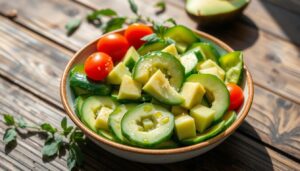Imagine a warm summer day. You’re looking for a refreshing and healthy meal that’s easy to make. A classic Greek salad is perfect for any occasion. It’s a staple of Mediterranean cuisine, made with simple yet vibrant ingredients like tomatoes, cucumbers, and feta cheese.
A classic Greek salad recipe includes vine-ripened tomatoes, cucumber, bell pepper, red onion, feta cheese, and kalamata olives. It’s dressed with olive oil, red wine vinegar, and fresh herbs. This mix creates a delicious and healthy meal that’s low in carbs and rich in vegetables. With about 187 calories per serving, it’s a great choice for a guilt-free meal.
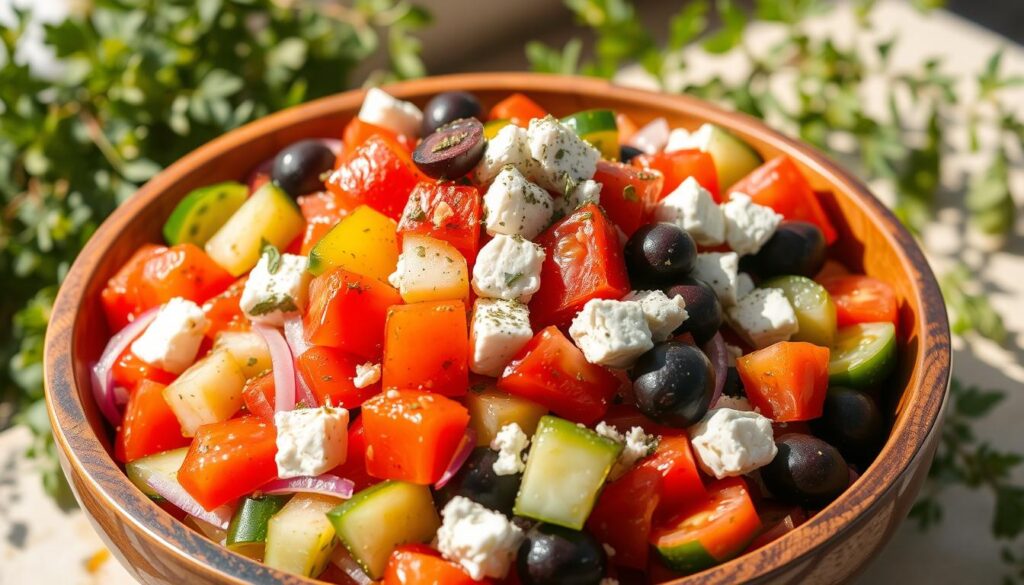
Whether you’re in the mood for a light lunch or a satisfying dinner, a classic Greek salad is a great choice. You can add protein sources like chicken or chickpeas to make it a complete meal. The best part is that it’s easy to prepare and can be made ahead of time. It stays fresh for 4 to 5 days when refrigerated.
Table of Contents
Key Takeaways
- A classic Greek salad recipe is a healthy and refreshing meal option
- An authentic Greek salad typically consists of tomatoes, cucumbers, bell pepper, red onion, feta cheese, and kalamata olives
- This homemade Greek salad is low in carbs and rich in vegetables, making it a great option for those looking for a guilt-free meal
- A serving of Greek salad contains approximately 187 calories and 4.7g of protein
- The salad can be customized by adding protein sources like chicken or chickpeas to make it a complete meal
- The shelf life of leftovers is 4 to 5 days when refrigerated, making it a convenient meal prep option
The History and Origins of Greek Salad
Before you make your own Greek salad, it’s good to know its history. The traditional Greek salad, or horiatiki, started in rural Greece. It was a simple meal for farmers and villagers. Now, it’s a key part of Mediterranean cuisine.
The salad has tomatoes, cucumbers, onions, feta cheese, and Kalamata olives. It’s loved in many places, including the U.S. To make a real Greek salad, use the best ingredients and follow old ways.
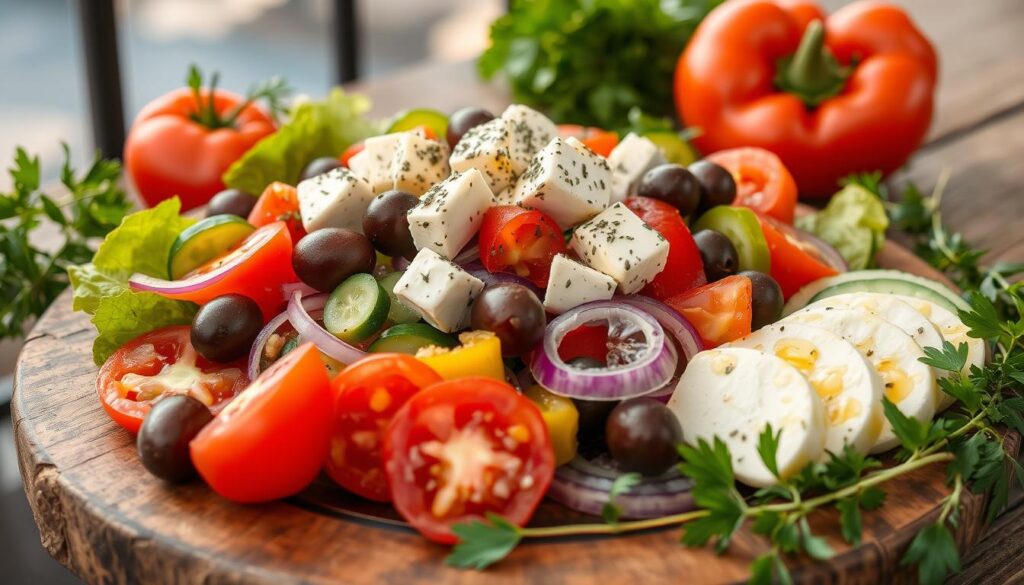
Greek salad is very important in Mediterranean food culture. In Greece, meals are times to come together. The Greek salad is often the main dish at these times. Exploring Greek cuisine, you’ll find many tasty dishes like the salad. Its history, cultural value, and flavors make it a must-try.
Some interesting facts about Greek salad’s history include:
- Tomatoes were introduced to Greece in the 19th century and became a staple ingredient in the traditional Greek salad.
- Regional variations of the Greek salad have emerged, incorporating local ingredients and flavors.
- The traditional Greek salad has become a popular dish worldwide, with many restaurants and home cooks adapting the recipe to suit their tastes.
Essential Ingredients for an Authentic Classic Greek Salad Recipe
To make a true authentic greek salad, you must use top-notch, fresh ingredients. The key greek salad ingredients are tomatoes, cucumbers, red onion, feta cheese, Kalamata olives, and green bell pepper. A simple mix of olive oil, red wine vinegar, and dried oregano makes the classic greek salad recipe.
Here are the must-have ingredients:
- Tomatoes: large chunks, preferably without cherry or grape tomatoes
- Cucumbers: sliced or chopped
- Red onion: thinly sliced
- Feta cheese: a substantial piece, not crumbled, made from sheep’s milk
- Kalamata olives: with pits, for an authentic touch
- Green bell pepper: strips, adding a crunchy texture
- Olive oil: extra-virgin, for dressing
- Red wine vinegar: a splash, for dressing
- Dried oregano: for added flavor
An authentic greek salad doesn’t have lettuce or other greens. It focuses on fresh veggies and tangy feta cheese. With these key greek salad ingredients, you’ll make a tasty and genuine classic greek salad recipe that everyone will love.
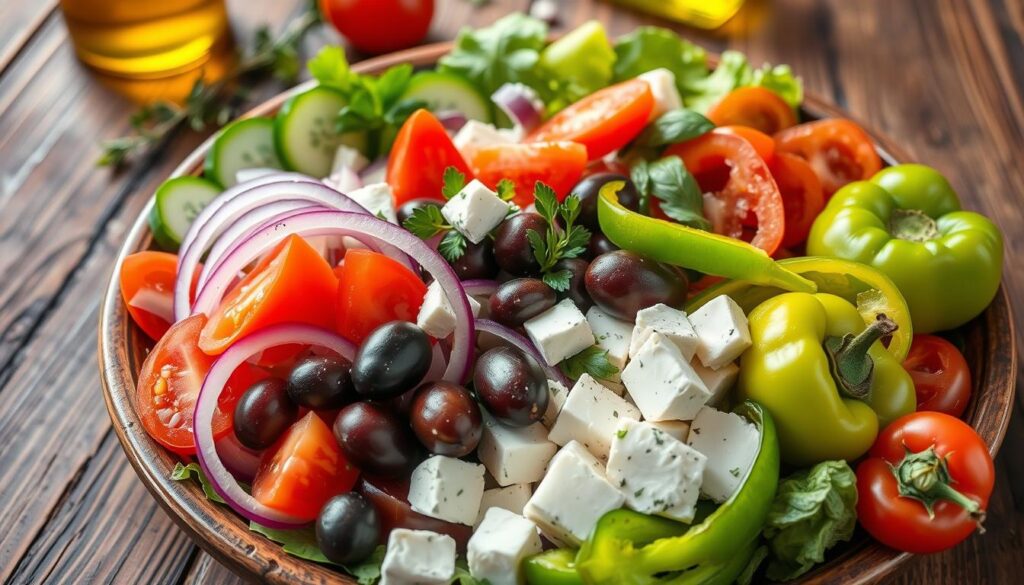
| Ingredient | Quantity | Preparation |
|---|---|---|
| Tomatoes | 4-6 | Chopped or sliced |
| Cucumbers | 2-3 | Sliced or chopped |
| Red onion | 1 | Thinly sliced |
| Feta cheese | 1 block | Not crumbled |
Choosing and Preparing Your Vegetables
To make a delicious homemade greek salad, pick the freshest ingredients. Look for ripe tomatoes, English or Persian cucumbers, and thin red onions. Some recipes tell you to marinate the onions in vinegar to soften them.
Here are some tips for preparing your veggies:
- Choose tomatoes that are firm and heavy for their size.
- Select cucumbers that are dark green and have a slight sheen to them.
- Use red onions and slice them thinly to add a sweet and crunchy texture to your easy greek salad recipe.
For a great greek salad, prep your veggies right. Slice cucumbers into half-moons and seed and julienne green bell peppers. Soaking sliced red onions in ice water with red wine vinegar can also help.
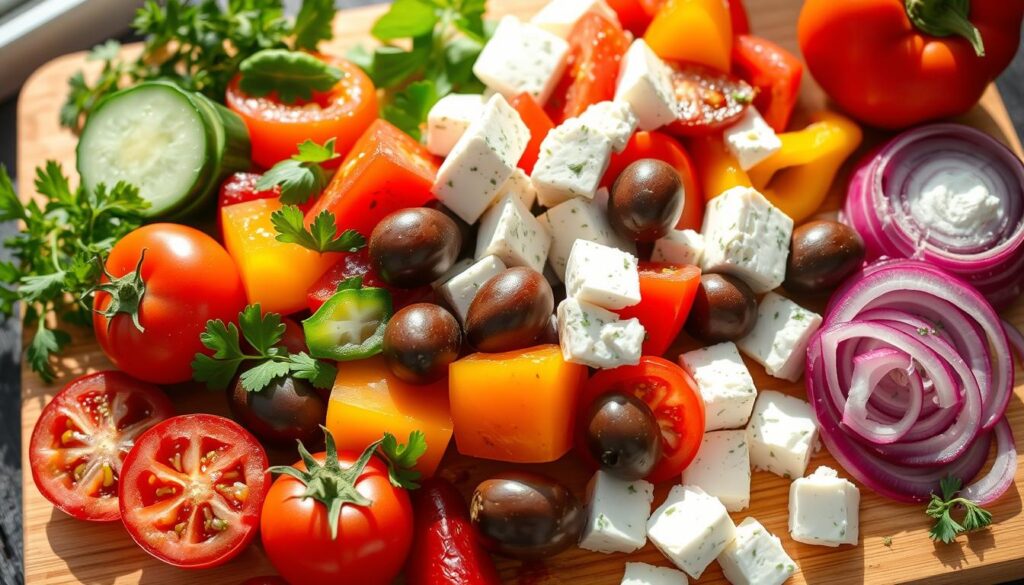
By following these tips and using the freshest ingredients, you’ll make a tasty homemade greek salad. It’s perfect for any time.
The Art of Greek Salad Dressing
Making an authentic Greek salad starts with the dressing. A classic recipe includes extra-virgin olive oil, red wine vinegar, and dried oregano. Sometimes, garlic and Dijon mustard are added too. For the best taste, use top-notch ingredients like extra-virgin olive oil.
Check out your local stores or veganbatter.com for healthy salad tips. Choose cold-pressed olive oil with low acidity for a smooth taste. Mix 6 tablespoons of olive oil with 2 tablespoons of red wine vinegar. Add a pinch of dried oregano, salt, and pepper to taste.
Traditional Dressing Components
A traditional Greek salad dressing has a few key ingredients:
- Extra-virgin olive oil
- Red wine vinegar
- Dried oregano
- Garlic
- Dijon mustard
These ingredients blend to make a tasty, refreshing dressing. It perfectly complements a classic Greek salad. With a simple recipe, you can make a delicious, authentic salad that everyone will love.
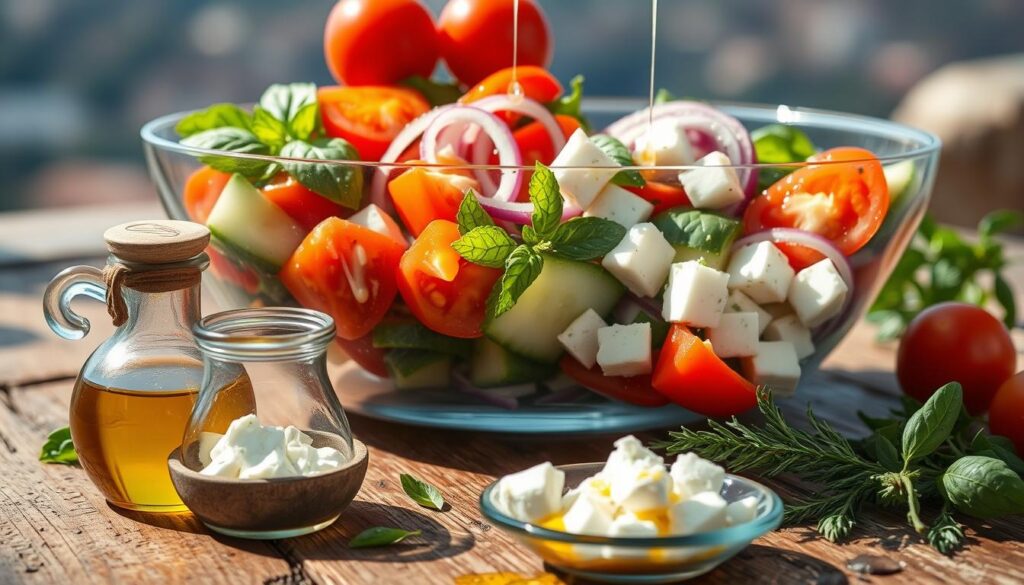
Olive Oil Selection Tips
Choose a high-quality olive oil for your dressing. It should have a rich, fruity taste. Try different types like Kalamata or Arbequina to find your favorite. Using great olive oil and a simple recipe will make your Greek salad a hit.
Step-by-Step Assembly Instructions
To make a tasty Greek salad, start by mixing chopped veggies in a bowl. Add Kalamata olives for a salty taste. Then, drizzle with a dressing made from olive oil, lemon juice, and herbs like oregano and parsley.
Next, sprinkle crumbled feta cheese on top. This is a key part of a traditional Greek salad. You can also add capers, red onion, and bell peppers for extra flavor and texture. For a quicker salad, use pre-chopped veggies and a store-bought dressing.
- Use fresh and high-quality ingredients for the best taste and texture.
- Avoid over-dressing your salad to prevent it from becoming soggy.
- Let your salad marinate for 30-60 minutes before serving. This helps the flavors mix well.
By following these steps and tips, you can make a delicious Greek salad. It’s perfect for a quick lunch or dinner. Your homemade salad will impress family and friends. Plus, you can adjust it to fit your taste and dietary needs.
| Ingredient | Quantity |
|---|---|
| Tomatoes | 4 medium-sized |
| Cucumber | 1 medium |
| Red onion | 1/2 medium |
| Kalamata olives | 1/2 cup |
The Perfect Feta: Selection and Incorporation
Choosing the right feta cheese is key for a true Greek salad. You need a high-quality feta for its tangy, salty taste. Sheep’s milk feta is the most authentic choice, as it’s often used in Greek salads.
For the best flavor, pick a feta made from sheep’s or a mix of sheep’s and goat’s milk. You can crumble or cut your feta into large pieces. Some like small crumbles, while others prefer big chunks. Traditional Greek salads often have a large feta piece on top.
Try pairing your salad with a mediterranean greek salad dressing. It’s made with olive oil, red wine vinegar, and Kalamata olives.
Different Types of Feta
There are many feta cheeses, each with its own taste and texture. Here are a few:
- Sheep’s milk feta: Known for its tangy, salty flavor.
- Goat’s milk feta: Milder and creamier than sheep’s milk feta.
- Buffalo’s milk feta: Rich and creamy, with a mild taste.
Think about the greek salad ingredients you’re using and the flavor you want. For a real authentic greek salad, sheep’s milk feta is best.
Proper Crumbling Techniques
To crumble your feta, place it in a bowl and use your fingers or a fork. You can also grate it for smaller pieces. For a rustic look, cut it into chunks and then crumble it.
Serving and Presentation Tips
When serving a summer greek salad, presentation matters a lot. You want to impress with your mediterranean salad recipe. Arrange the ingredients to make a colorful display. Use a large bowl or platter to show off the salad’s vibrant colors. Make sure to place the feta cheese on top.
A simple greek salad is all about being fresh and simple. Don’t over-toss the ingredients. Instead, mix them gently to keep the colors bright. You can add crusty bread or grilled meats on the side. For a real Greek touch, serve with traditional greek salad dressing and dried oregano.
To spice up your mediterranean salad recipe, try adding capers or red wine vinegar. You can also use different cheeses, like Dodoni Feta Cheese. For more ideas, look at other mediterranean salad recipes and get creative with your simple greek salad!
Grilled meats, gyros, and pita sandwiches go great with a summer greek salad. You can also serve it as a light main dish or a side for a big event. Your mediterranean salad recipe will definitely be a hit!
Health Benefits and Nutritional Information
A healthy greek salad is not just tasty, but also packed with nutrients. It’s low in calories and carbs, perfect for those watching their weight or eating healthy.
Cucumbers are full of potassium, while tomatoes are rich in vitamin C and A. Feta cheese adds protein and calcium. Healthy eating is easy with a greek salad.
Caloric Content and Macronutrients
A typical greek salad has about 160 calories. It has 8g of carbs, 3g of protein, and 14g of fat. It’s great for those watching their calorie intake but still need nutrients.
Mediterranean Diet Benefits
The mediterranean greek salad is key to the mediterranean diet. It’s known to lower heart disease and cholesterol risks. Olive oil and red wine vinegar add healthy fats.
Vitamin and Mineral Content
A greek salad is full of vitamins and minerals, including:
- Vitamin C: 36mg
- Vitamin A: 1231IU
- Calcium: 94mg
- Iron: 1mg
In summary, a healthy greek salad is a great diet addition. It offers essential nutrients and health benefits. Whether you prefer a simple or mediterranean greek salad, it’s a winner.
Modern Variations and Adaptations
Greek salad variations are endless. You can add lettuce, use different olives, or include capers, anchovies, or grilled chicken. This makes for a unique Mediterranean salad. For an easy recipe, use pre-cut veggies to save time.
A Mediterranean salad recipe can be tailored to fit your taste or dietary needs. You can add grilled chicken for more protein or try different olives for flavor. Adding lettuce, capers, or anchovies can also change the salad’s taste.
Some popular Greek salad variations include:
- Adding grilled chicken or shrimp for extra protein
- Using different types of olives, such as Kalamata or green olives
- Incorporating fresh herbs like dill or parsley
- Adding a creamy element, such as Greek yogurt or feta cheese
To make your own easy Greek salad, use fresh, seasonal ingredients. Don’t be afraid to try new combinations. With a bit of creativity, you can make a unique Mediterranean salad that fits your taste and needs.
Conclusion: Mastering Your Greek Salad Journey
Discovering the perfect classic Greek salad is a fun journey. It’s filled with fresh tastes and rich culture. This guide has given you the basics to make this beloved dish.
The secret to a great simple Greek salad is using top-notch ingredients. Look for the best tomatoes, cucumbers, and red onions. Add creamy feta cheese and a good extra virgin olive oil for that Greek taste. A sprinkle of oregano and a bit of red wine vinegar will make it perfect.
Keep exploring with your classic Greek salad recipe. Try adding grilled veggies, seafood, or legumes. This dish is very flexible, letting you add your own twist while keeping the Greek spirit alive. Enjoy the simplicity and freshness, and let the Greek salad take you to the Mediterranean.
F.A.Q
What are the key ingredients in a classic Greek salad?
A true Greek salad has fresh tomatoes, cucumbers, and red onions. It also includes kalamata olives and feta cheese. The dressing is simple, with olive oil, vinegar, and oregano.
How do I properly prepare the vegetables for a Greek salad?
Pick ripe, tasty tomatoes and crisp cucumbers. Thinly slice the red onions. Seeding the cucumbers is up to you.
What makes a good Greek salad dressing?
Great Greek salad dressing uses top-notch olive oil and red wine vinegar or lemon juice. Add dried oregano, salt, and pepper. This simple mix lets the veggies’ flavors stand out.
How should I assemble and serve a classic Greek salad?
Mix the veggies, olives, and feta cheese together. You can dress it before serving or let guests do it themselves. Serve in a big bowl or on a platter for a nice look.
What type of feta cheese is best for a traditional Greek salad?
For real flavor, choose Greek-style feta cheese. It’s made from sheep’s or goat’s milk. This gives it a tangy, crumbly texture that’s perfect for the salad.
What are some modern variations of the Greek salad?
You can try new things with the Greek salad. Add grilled chicken or shrimp for protein. Use different olives or add lettuce and capers for a twist.
What are the health benefits of a Greek salad?
Greek salads are full of good stuff. They have veggies, healthy fats from olive oil and olives, and protein from feta cheese. It’s a balanced, low-calorie meal that’s good for you.

